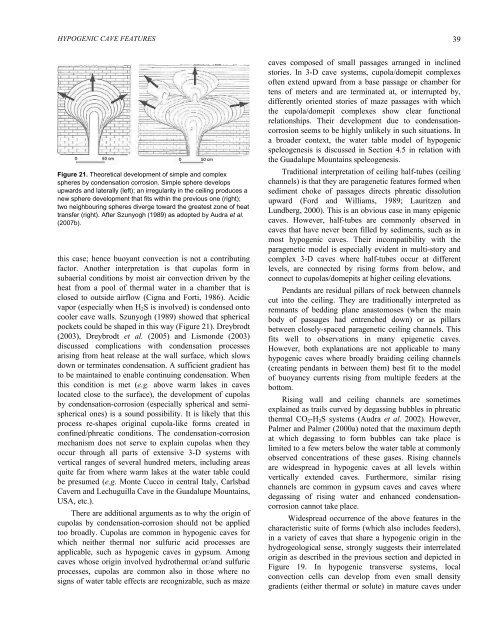Download PDF - Speleogenesis
Download PDF - Speleogenesis
Download PDF - Speleogenesis
Create successful ePaper yourself
Turn your PDF publications into a flip-book with our unique Google optimized e-Paper software.
HYPOGENIC CAVE FEATURES<br />
Figure 21. Theoretical development of simple and complex<br />
spheres by condensation corrosion. Simple sphere develops<br />
upwards and laterally (left); an irregularity in the ceiling produces a<br />
new sphere development that fits within the previous one (right);<br />
two neighbouring spheres diverge toward the greatest zone of heat<br />
transfer (right). After Szunyogh (1989) as adopted by Audra et al.<br />
(2007b).<br />
this case; hence buoyant convection is not a contributing<br />
factor. Another interpretation is that cupolas form in<br />
subaerial conditions by moist air convection driven by the<br />
heat from a pool of thermal water in a chamber that is<br />
closed to outside airflow (Cigna and Forti, 1986). Acidic<br />
vapor (especially when H2S is involved) is condensed onto<br />
cooler cave walls. Szunyogh (1989) showed that spherical<br />
pockets could be shaped in this way (Figure 21). Dreybrodt<br />
(2003), Dreybrodt et al. (2005) and Lismonde (2003)<br />
discussed complications with condensation processes<br />
arising from heat release at the wall surface, which slows<br />
down or terminates condensation. A sufficient gradient has<br />
to be maintained to enable continuing condensation. When<br />
this condition is met (e.g. above warm lakes in caves<br />
located close to the surface), the development of cupolas<br />
by condensation-corrosion (especially spherical and semispherical<br />
ones) is a sound possibility. It is likely that this<br />
process re-shapes original cupola-like forms created in<br />
confined/phreatic conditions. The condensation-corrosion<br />
mechanism does not serve to explain cupolas when they<br />
occur through all parts of extensive 3-D systems with<br />
vertical ranges of several hundred meters, including areas<br />
quite far from where warm lakes at the water table could<br />
be presumed (e.g. Monte Cucco in central Italy, Carlsbad<br />
Cavern and Lechuguilla Cave in the Guadalupe Mountains,<br />
USA, etc.).<br />
There are additional arguments as to why the origin of<br />
cupolas by condensation-corrosion should not be applied<br />
too broadly. Cupolas are common in hypogenic caves for<br />
which neither thermal nor sulfuric acid processes are<br />
applicable, such as hypogenic caves in gypsum. Among<br />
caves whose origin involved hydrothermal or/and sulfuric<br />
processes, cupolas are common also in those where no<br />
signs of water table effects are recognizable, such as maze<br />
caves composed of small passages arranged in inclined<br />
stories. In 3-D cave systems, cupola/domepit complexes<br />
often extend upward from a base passage or chamber for<br />
tens of meters and are terminated at, or interrupted by,<br />
differently oriented stories of maze passages with which<br />
the cupola/domepit complexes show clear functional<br />
relationships. Their development due to condensationcorrosion<br />
seems to be highly unlikely in such situations. In<br />
a broader context, the water table model of hypogenic<br />
speleogenesis is discussed in Section 4.5 in relation with<br />
the Guadalupe Mountains speleogenesis.<br />
Traditional interpretation of ceiling half-tubes (ceiling<br />
channels) is that they are paragenetic features formed when<br />
sediment choke of passages directs phreatic dissolution<br />
upward (Ford and Williams, 1989; Lauritzen and<br />
Lundberg, 2000). This is an obvious case in many epigenic<br />
caves. However, half-tubes are commonly observed in<br />
caves that have never been filled by sediments, such as in<br />
most hypogenic caves. Their incompatibility with the<br />
paragenetic model is especially evident in multi-story and<br />
complex 3-D caves where half-tubes occur at different<br />
levels, are connected by rising forms from below, and<br />
connect to cupolas/domepits at higher ceiling elevations.<br />
Pendants are residual pillars of rock between channels<br />
cut into the ceiling. They are traditionally interpreted as<br />
remnants of bedding plane anastomoses (when the main<br />
body of passages had entrenched down) or as pillars<br />
between closely-spaced paragenetic ceiling channels. This<br />
fits well to observations in many epigenetic caves.<br />
However, both explanations are not applicable to many<br />
hypogenic caves where broadly braiding ceiling channels<br />
(creating pendants in between them) best fit to the model<br />
of buoyancy currents rising from multiple feeders at the<br />
bottom.<br />
Rising wall and ceiling channels are sometimes<br />
explained as trails curved by degassing bubbles in phreatic<br />
thermal CO2-H2S systems (Audra et al. 2002). However,<br />
Palmer and Palmer (2000a) noted that the maximum depth<br />
at which degassing to form bubbles can take place is<br />
limited to a few meters below the water table at commonly<br />
observed concentrations of these gases. Rising channels<br />
are widespread in hypogenic caves at all levels within<br />
vertically extended caves. Furthermore, similar rising<br />
channels are common in gypsum caves and caves where<br />
degassing of rising water and enhanced condensationcorrosion<br />
cannot take place.<br />
Widespread occurrence of the above features in the<br />
characteristic suite of forms (which also includes feeders),<br />
in a variety of caves that share a hypogenic origin in the<br />
hydrogeological sense, strongly suggests their interrelated<br />
origin as described in the previous section and depicted in<br />
Figure 19. In hypogenic transverse systems, local<br />
convection cells can develop from even small density<br />
gradients (either thermal or solute) in mature caves under<br />
39
















